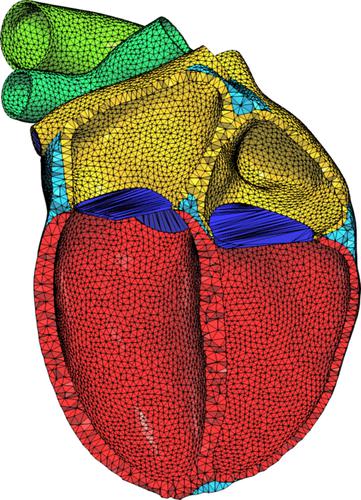当前位置:
X-MOL 学术
›
Int. J. Numer. Method. Biomed. Eng.
›
论文详情
Our official English website, www.x-mol.net, welcomes your
feedback! (Note: you will need to create a separate account there.)
Using parametric model order reduction for inverse analysis of large nonlinear cardiac simulations.
International Journal for Numerical Methods in Biomedical Engineering ( IF 2.2 ) Pub Date : 2020-02-24 , DOI: 10.1002/cnm.3320 M R Pfaller 1 , M Cruz Varona 2 , J Lang 1 , C Bertoglio 3 , W A Wall 1
International Journal for Numerical Methods in Biomedical Engineering ( IF 2.2 ) Pub Date : 2020-02-24 , DOI: 10.1002/cnm.3320 M R Pfaller 1 , M Cruz Varona 2 , J Lang 1 , C Bertoglio 3 , W A Wall 1
Affiliation

|
Predictive high‐fidelity finite element simulations of human cardiac mechanics commonly require a large number of structural degrees of freedom. Additionally, these models are often coupled with lumped‐parameter models of hemodynamics. High computational demands, however, slow down model calibration and therefore limit the use of cardiac simulations in clinical practice. As cardiac models rely on several patient‐specific parameters, just one solution corresponding to one specific parameter set does not at all meet clinical demands. Moreover, while solving the nonlinear problem, 90% of the computation time is spent solving linear systems of equations. We propose to reduce the structural dimension of a monolithically coupled structure‐Windkessel system by projection onto a lower‐dimensional subspace. We obtain a good approximation of the displacement field as well as of key scalar cardiac outputs even with very few reduced degrees of freedom, while achieving considerable speedups. For subspace generation, we use proper orthogonal decomposition of displacement snapshots. Following a brief comparison of subspace interpolation methods, we demonstrate how projection‐based model order reduction can be easily integrated into a gradient‐based optimization. We demonstrate the performance of our method in a real‐world multivariate inverse analysis scenario. Using the presented projection‐based model order reduction approach can significantly speed up model personalization and could be used for many‐query tasks in a clinical setting.
中文翻译:

使用参数模型降阶进行大型非线性心脏仿真的逆分析。
对人类心脏力学进行预测的高保真有限元模拟通常需要大量的结构自由度。此外,这些模型通常与血液动力学的集总参数模型结合在一起。但是,较高的计算需求会减慢模型校准的速度,因此限制了心脏模拟在临床实践中的使用。由于心脏模型依赖于多个患者特定的参数,因此仅一种解决方案对应于一个特定的参数集根本无法满足临床需求。此外,在解决非线性问题时,90%的计算时间花费在求解方程的线性系统上。我们建议通过投影到低维子空间上来减小整体耦合结构Windkessel系统的结构尺寸。我们获得了位移场以及关键标量心输出量的良好近似值,即使自由度几乎没有降低,同时也实现了相当大的加速比。对于子空间生成,我们使用位移快照的适当正交分解。在对子空间插值方法进行简要比较之后,我们演示了如何轻松地将基于投影的模型降阶集成到基于梯度的优化中。我们在真实的多元逆分析场景中证明了我们方法的性能。使用提出的基于投影的模型降阶方法可以显着加速模型个性化,并且可以用于临床环境中的许多查询任务。同时实现可观的加速。对于子空间生成,我们使用位移快照的适当正交分解。在对子空间插值方法进行简要比较之后,我们演示了如何轻松地将基于投影的模型降阶集成到基于梯度的优化中。我们在真实的多元逆分析场景中证明了我们方法的性能。使用提出的基于投影的模型降阶方法可以显着加速模型个性化,并且可以用于临床环境中的许多查询任务。同时实现可观的加速。对于子空间生成,我们使用位移快照的适当正交分解。在对子空间插值方法进行了简要比较之后,我们演示了如何轻松地将基于投影的模型降阶集成到基于梯度的优化中。我们在真实的多元逆分析场景中证明了我们方法的性能。使用提出的基于投影的模型降阶方法可以显着加速模型个性化,并且可以用于临床环境中的许多查询任务。我们演示了如何将基于投影的模型降阶轻松地集成到基于梯度的优化中。我们在真实的多元逆分析场景中证明了我们方法的性能。使用提出的基于投影的模型降阶方法可以显着加速模型个性化,并且可以用于临床环境中的许多查询任务。我们演示了如何将基于投影的模型降阶轻松地集成到基于梯度的优化中。我们在真实的多元逆分析场景中证明了我们方法的性能。使用提出的基于投影的模型降阶方法可以显着加速模型个性化,并且可以用于临床环境中的许多查询任务。
更新日期:2020-02-24
中文翻译:

使用参数模型降阶进行大型非线性心脏仿真的逆分析。
对人类心脏力学进行预测的高保真有限元模拟通常需要大量的结构自由度。此外,这些模型通常与血液动力学的集总参数模型结合在一起。但是,较高的计算需求会减慢模型校准的速度,因此限制了心脏模拟在临床实践中的使用。由于心脏模型依赖于多个患者特定的参数,因此仅一种解决方案对应于一个特定的参数集根本无法满足临床需求。此外,在解决非线性问题时,90%的计算时间花费在求解方程的线性系统上。我们建议通过投影到低维子空间上来减小整体耦合结构Windkessel系统的结构尺寸。我们获得了位移场以及关键标量心输出量的良好近似值,即使自由度几乎没有降低,同时也实现了相当大的加速比。对于子空间生成,我们使用位移快照的适当正交分解。在对子空间插值方法进行简要比较之后,我们演示了如何轻松地将基于投影的模型降阶集成到基于梯度的优化中。我们在真实的多元逆分析场景中证明了我们方法的性能。使用提出的基于投影的模型降阶方法可以显着加速模型个性化,并且可以用于临床环境中的许多查询任务。同时实现可观的加速。对于子空间生成,我们使用位移快照的适当正交分解。在对子空间插值方法进行简要比较之后,我们演示了如何轻松地将基于投影的模型降阶集成到基于梯度的优化中。我们在真实的多元逆分析场景中证明了我们方法的性能。使用提出的基于投影的模型降阶方法可以显着加速模型个性化,并且可以用于临床环境中的许多查询任务。同时实现可观的加速。对于子空间生成,我们使用位移快照的适当正交分解。在对子空间插值方法进行了简要比较之后,我们演示了如何轻松地将基于投影的模型降阶集成到基于梯度的优化中。我们在真实的多元逆分析场景中证明了我们方法的性能。使用提出的基于投影的模型降阶方法可以显着加速模型个性化,并且可以用于临床环境中的许多查询任务。我们演示了如何将基于投影的模型降阶轻松地集成到基于梯度的优化中。我们在真实的多元逆分析场景中证明了我们方法的性能。使用提出的基于投影的模型降阶方法可以显着加速模型个性化,并且可以用于临床环境中的许多查询任务。我们演示了如何将基于投影的模型降阶轻松地集成到基于梯度的优化中。我们在真实的多元逆分析场景中证明了我们方法的性能。使用提出的基于投影的模型降阶方法可以显着加速模型个性化,并且可以用于临床环境中的许多查询任务。











































 京公网安备 11010802027423号
京公网安备 11010802027423号